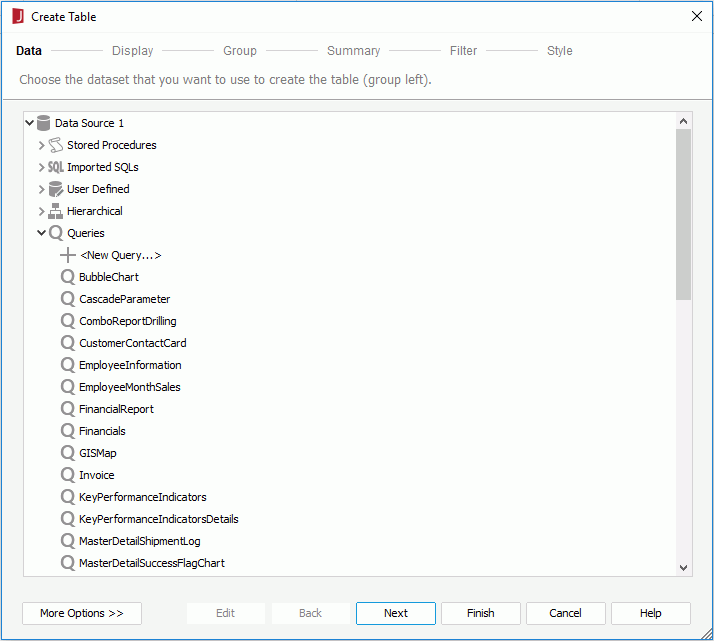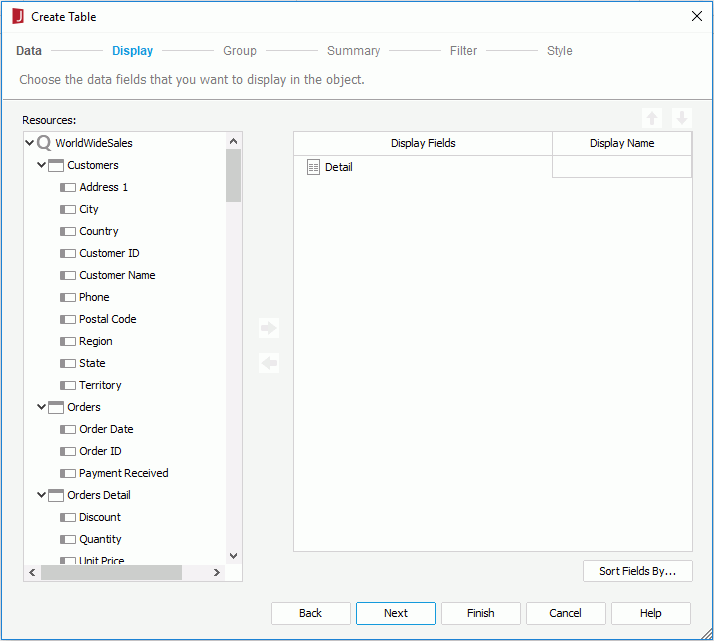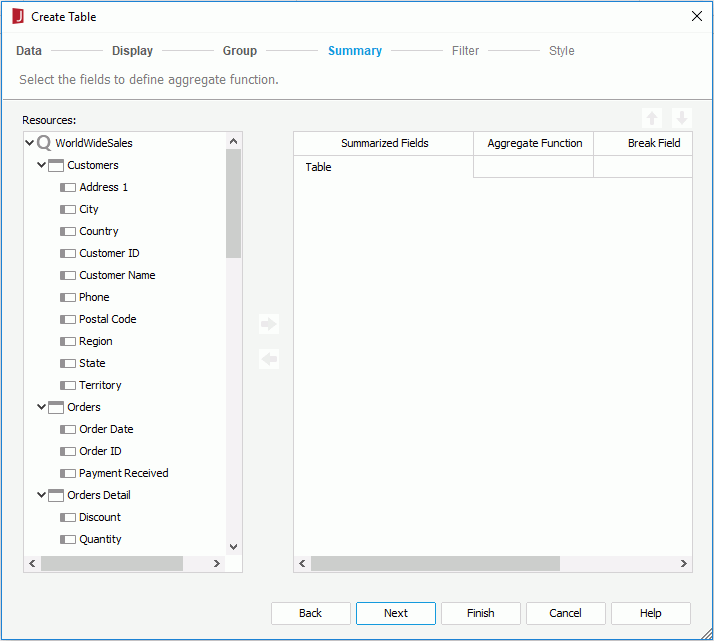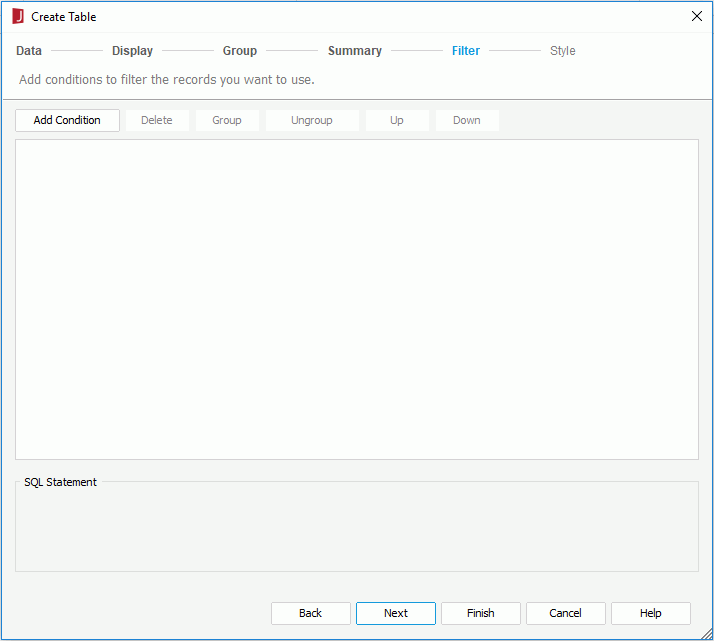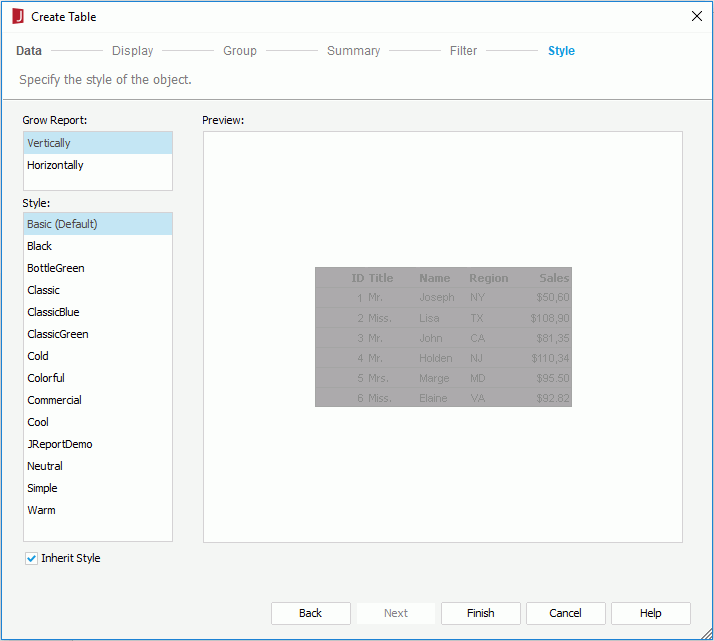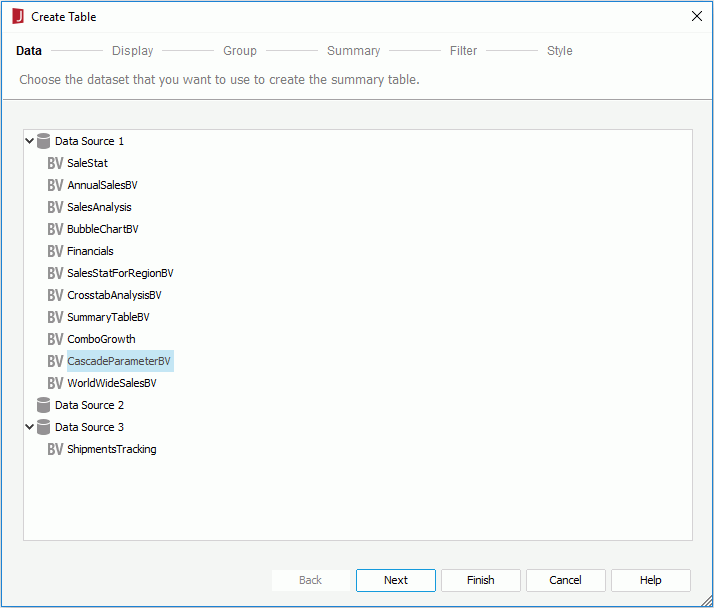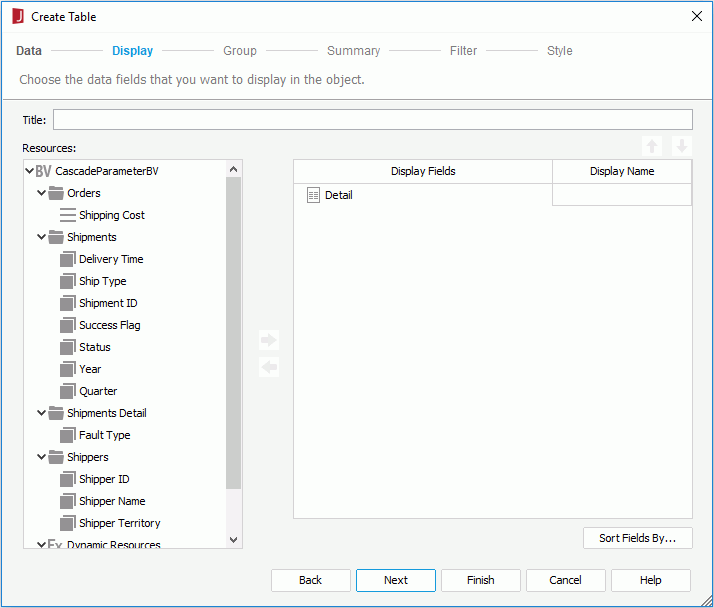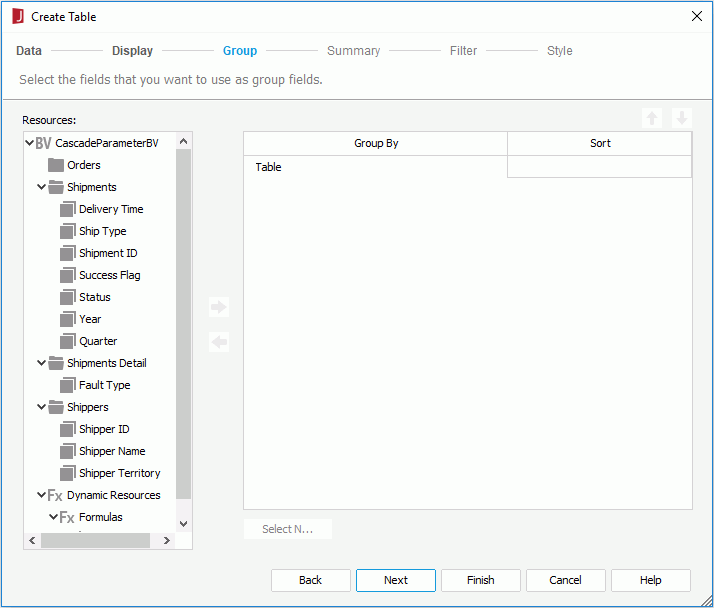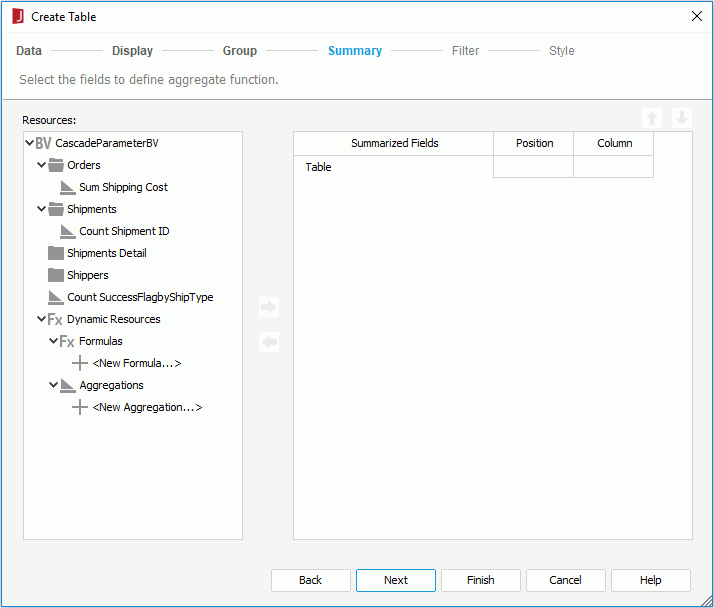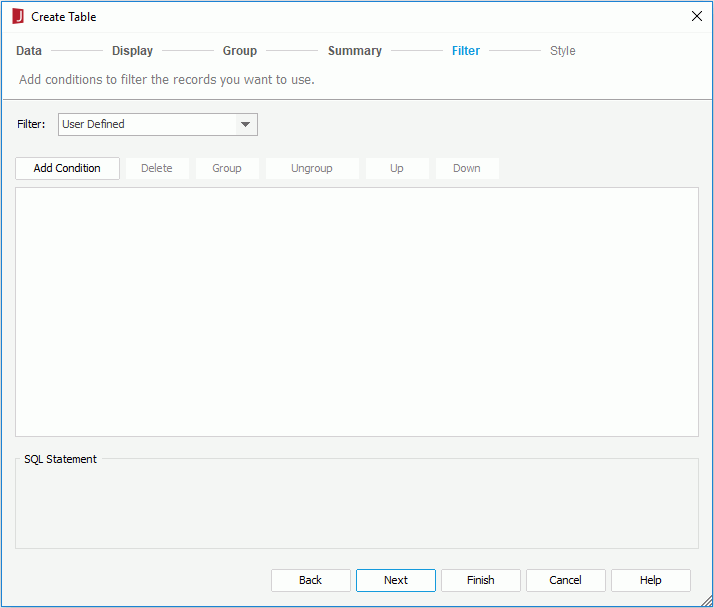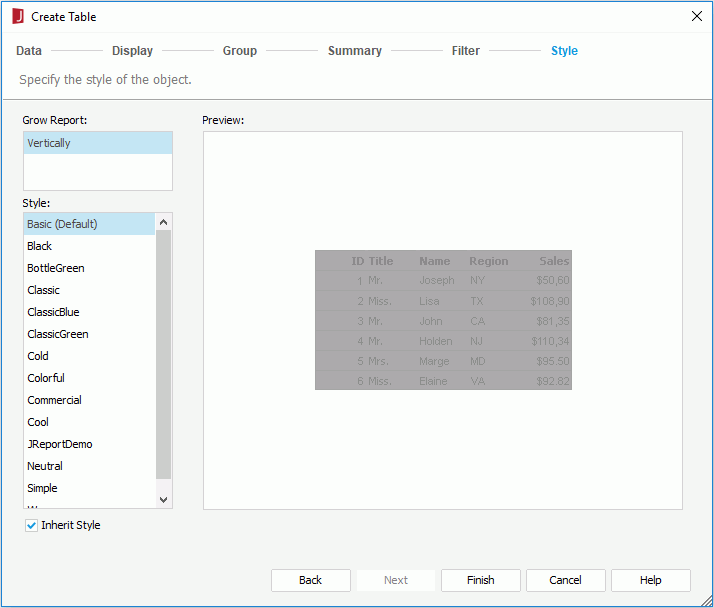Create Table Dialog (for Page Report)
The Create Table dialog for page report differs according to the data resource type used to create the table: query resource or business view.
When using a Query Resource
This wizard appears when you choose a table type and select OK in the Table Type dialog, or drag the desired table type button from the Components panel into a page report that is created using query resources. It helps you to create a table in the page report, and consists of the following screens:
Back
Goes back to the previous screen.
Next
Goes to the next screen.
Finish
Finishes creating the table and closes this dialog.
Cancel
Does not retain changes and closes this dialog.
Help
Displays the help document about this feature.
Data
Specifies the dataset that you want to use to create the table. See the screen.
Resource box
Lists the available data resources in the current catalog. Select one to create the table.
More Options/Less Options
Shows or hides the dataset selection panel to choose a dataset for the table.
- New Dataset
If checked, select a data source from the catalog resources to create a dataset that will be used to build the table. When you choose to create the dataset from a query, you can select the Edit button to edit the query in the Query Editor if required. - ExistingDataset
If checked, select a dataset from the ones existing in the open report to create the table. You can select the Edit button to edit the dataset in the Dataset Editor if required. - CurrentDataset
If checked, the current dataset used by the parent object will be applied to the table.
Display
Specifies the fields that you want to display in the table. See the screen.
Resources
Lists all the available data resources.

Adds the specified field to use in the table.

Removes the specified field that is not required in the table.

Moves the specified field one step up.

Moves the specified field one step down.
Display Fields
Lists the fields that have been selected to display in the table.
Display Name
Shows the display names of the selected fields. You can select the name cells to edit them if required.
Sort Fields By
Opens the Sort Fields By dialog to specify how to sort data in the table.
Group
Specifies the fields that you want to use to group the data. See the screen.
Resources
Lists all the available data resources.

Adds the selected field as the group by field in the table.

Removes the selected group by field that is not required.

Moves the specified group one step up.

Moves the specified group one step down.
Group By
Lists the fields that are used to group data in the table.
Sort
Specifies how groups at the specific group level will be sorted.
- Ascend
Groups will be sorted in an ascending order (A, B, C). - Descend
Groups will be sorted in a descending order (C, B, A). - No Sort
Groups will be sorted in the original order in database. - Special Group
Opens the User Defined Group dialog to define grouping information.For example, if you placed a field named Region for grouping, and this field contains all 50 states of the United States; and if you want to see the data between Maryland (MD) and New York (NY), you can define the criteria by selecting the between operator to further define your grouping information.
- Custom Sort
Opens the Custom Sort dialog to set how groups will be sorted.
Special Function
If the group by field is of Numeric/String/Date/Time type, you can select a special function for the field in the Special Function column to further specify to which level the data will be grouped by.
If Customize is selected, the Customized Function dialog will be displayed, in which you can set the function by your own.
Custom Sort
Specifies how to sort the groups. Activated only when you have selected Custom Sort from the Sort column to define the sorting manner of groups for the selected group level.
Special Group
Specifies how to group your information. Activated only when you have selected Special Group from the Sort column to define a special group.
Select N
Opens the Select N dialog to specify the Select N condition.
Group Filter
Opens the Group Filter dialog to specify the group filter condition.
Summary
Specifies the fields on which you want to create aggregate functions. See the screen.
Resources
Lists all the available data resources.

Adds the selected field as the summary field to the table.

Removes the selected summary field that is not required.

Moves the specified summary field one step up.

Moves the specified summary field one step down.
Summarized Fields
Lists all the fields that you want to display and to be summarized in the table.
Aggregate Function
Specifies the function to summarize the selected field.
Break Field
Displays a defined field on which the summary will be calculated. If a summary field is added below the Table node, the break field is null and the summary will be calculated on the whole dataset.
Position
Works together with the Column option to specify the location where the summary field will be put. Not available when the table type is Group Above.
- Header
Specifies to put the summary field in the header row. If the summary is calculated on a group by field, it will be put in the group header row of the corresponding group; if the summary is calculated on the whole dataset, it will be put in the table header row. - Footer
Specifies to put the summary field in the footer row. If the summary is calculated on a group by field, it will be put in the group footer row of the corresponding group; if the summary is calculated on the whole dataset, it will be put in the table footer row.
Column
Works together with the Position option to specify the location where the summary field will be put. Not available when the table type is Group Above.
- Detail
The summary field with its label will be put in the first two detail columns. - Summary
The summary field will be displayed in a separate summary column.
Filter
Specifies to filter data displayed in the table. See the screen.
The options in the screen are the same as those in the Edit Filter dialog.
Style
Specifies the style of the table. See the screen.
Grow Report
Specifies the layout of the table.
- Vertically
Creates a vertical table. - Horizontally
Creates a horizontal table.
Style
Specifies the style of the table.
Preview
Displays the selected layout and style effects.
Inherit Style
Specifies whether to make the table take the style of its parent. Available only when the table is to be inserted into a banded object.
When using a Business View
This wizard appears when you choose a table type and select OK in the Table Type dialog, or drag the desired table type button from the Components panel into a page report that is created using business views. It helps you to create a table in the page report, and consists of the following screens:
Back
Goes back to the previous screen.
Next
Goes to the next screen.
Finish
Finishes creating the table and closes this dialog.
Cancel
Does not retain changes and closes this dialog.
Help
Displays the help document about this feature.
Data
Specifies the dataset that you want to use to create the table. See the screen.
Resource box
Lists the available business views in the current catalog. Select one to create the table.
Display
Specifies the fields that you want to display in the table. See the screen.
Title
Specifies the title for the table.
Resources
Lists all the available data resources.

Adds the specified field to use in the table.

Removes the specified field that is not required in the table.

Moves the specified field one step up.

Moves the specified field one step down.
Display Fields
Lists the fields that have been selected to display in the table.
Display Name
Shows the display names of the selected fields. You can select the name cells to edit them if required.
Sort Fields By
Opens the Sort Fields By dialog to specify how to sort data in the table.
Group
Specifies the fields that you want to use to group the data. See the screen.
Resources
Lists all the available data resources.

Adds the selected field as the group by field in the table.

Removes the selected group by field that is not required.

Moves the specified group one step up.

Moves the specified group one step down.
Group By
Lists the fields that are used to group data in the table.
Sort
Specifies how groups at the specific group level will be sorted.
- Ascend
Groups will be sorted in an ascending order (A, B, C). - Descend
Groups will be sorted in a descending order (C, B, A). - No Sort
Groups will be sorted in the original order in database. - Custom Sort
Opens the Custom Sort dialog to set how groups will be sorted.
Select N
Opens the Select N dialog to specify the Select N condition.
Summary
Specifies the aggregations to display in the table. See the screen.
Resources
Lists all the available aggregations.

Adds the selected aggregation to the table.

Removes the selected aggregation that is not required.

Moves the specified aggregation one step up.

Moves the specified aggregation one step down.
Summarized Fields
Lists all the aggregations that you want to display in the table. If an aggregation is added under the Table node, it will be displayed in the table panel. If an aggregation is added under the node of a specific group, it will be displayed in the corresponding group panel.
Position
Works together with the Column option to specify the location where the aggregation will be put.
- Footer
Specifies to put the aggregation in the footer row. If the aggregation is calculated on a group by field, it will be put in the group footer row of the corresponding group; if the aggregation is calculated on the whole dataset, it will be put in the table footer row.
Column
Works together with the Position option to specify the location where the aggregation will be put.
- Detail
The aggregation with its label will be put in in the first two detail columns.
Filter
Specifies to filter data displayed in the table. See the screen.
The options in the screen are the same as those in the Edit Filter dialog.
Style
Specifies the style of the table. See the screen.
Grow Report
Specifies the layout of the table.
- Vertically
Creates a vertical table.
Style
Specifies the style of the table.
Preview
Displays the selected layout and style effects.
Inherit Style
Specifies whether to make the table take the style of its parent. Available only when the table is to be inserted into a banded object.
 Previous Topic
Previous Topic
